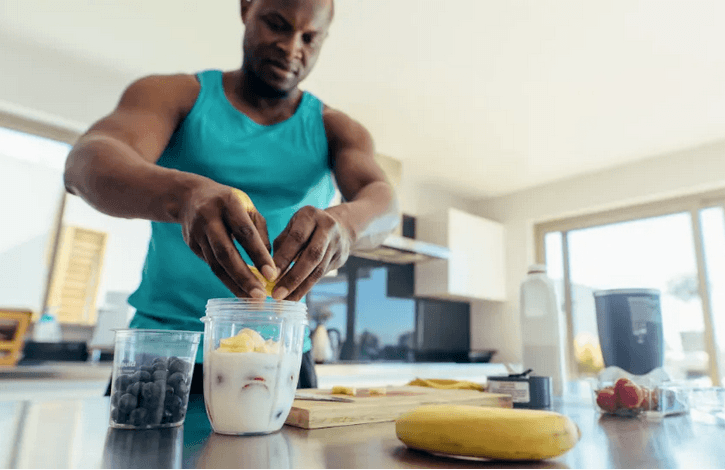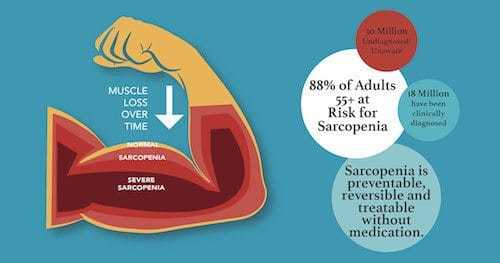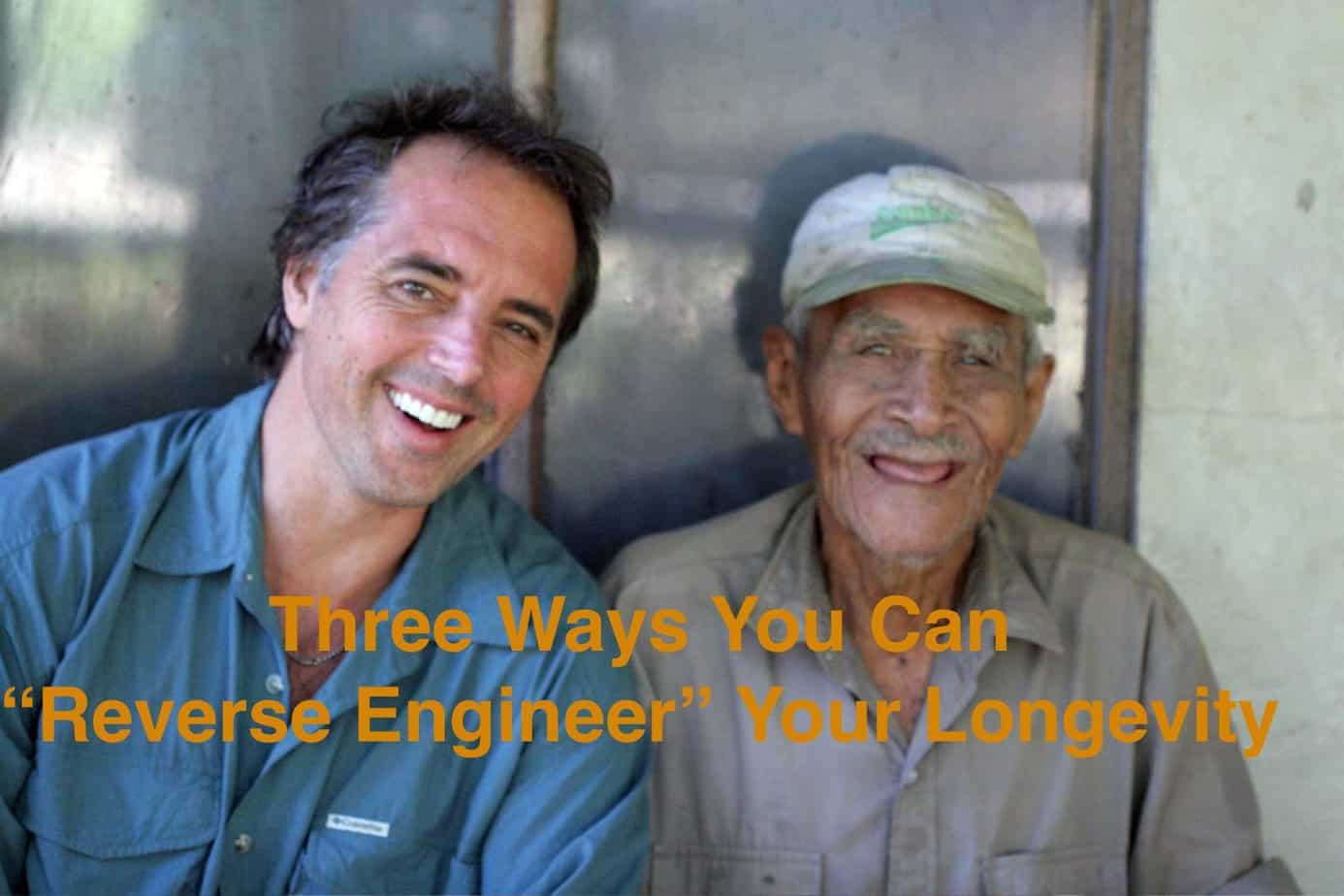Here’s How To Increase Healthspan With Exercise and Diet, Says Science.

To increase healthspan is to live healthier longer. Right now the best way to do that is to exercise your heart and muscle, and nourish your body with the right nutrition, say scientific studies.
In the early 16th century, Spanish Conquistador Ponce de León wanted to do more than simply increase healthspan. He searched for the mythical Fountain of Youth that would keep you young eternally, so the story goes. Now, several hundreds of years later, we don’t want to swim in any pool (too much exercise?), but rather pop some magic pill that restores our youth.
And while it’s true that many biotech firms are diligently working on something like that, you might get very old waiting for such a miracle. Instead of waiting around for something that may never happen — and die sooner than needed by some chronic disease — you can increase your healthspan by embracing what we know are the foundations of healthy aging — diet and exercise.
This is not to say that there aren’t many other things you can do to slow down the clock and increase healthspan. For instance, I offer a plan to Subscribers who want to “ bend their age curve”:
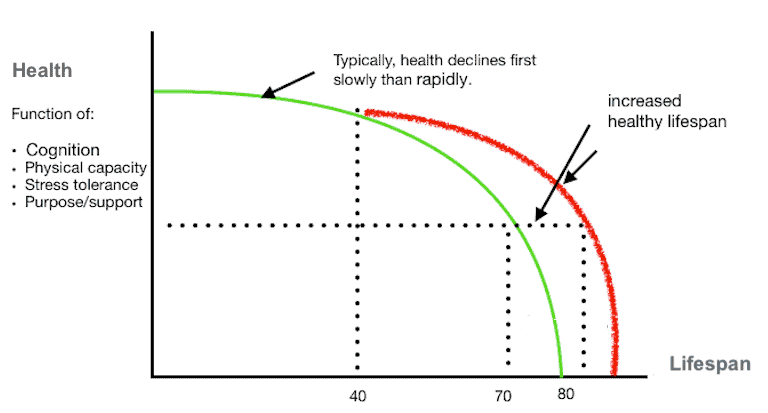 Beyond the common variety of diet and exercise suggestions, the prescription I provide for extending healthspan, possibly lifespan, includes a focus on factors such as:
Beyond the common variety of diet and exercise suggestions, the prescription I provide for extending healthspan, possibly lifespan, includes a focus on factors such as:
- A resilient mindset
- Nutrient timing
- Microbiota diversity
- Restorative sleep
- Three-phase detoxification
- Hormonal balance
- Mobility
- Functional strength
Note that several of these are about diet and exercise — which needs to be your primary focus, as I’ll explain — but part of the “protocol” is also a bundle of pills, sorta speak; however, they’re not pharmaceutical drugs, nor are they “magic”. Instead, these are nutraceuticals that have been well studied, and are thought to be useful to help you live a long and strong life, such as:
- Senolytics that decrease the number of senescent cells in the body, referred to as “zombie cells” — neither alive or dead they nonetheless secrete harmful chemicals that age you.
- NAD+ precursors, such as NMN and NR, that research shows activate a family of proteins called sirtuins, our longevity genes.
- Autophagy (cellular housecleaning) stimulated by caloric mimicking via the ProLon Fasting Mimicking Diet and intermittent fasting.
Senolytics, NAD+ precursors and upregulating autophagy are all very useful tactics to live healthier, longer, but they aren’t as important as diet and exercise, as one of the world’s foremost authorities on aging interventions, Dr. Thomas Rando, will affirm.
Increase Healthspan With Cardiovascular Exercise
Dr. Rando is well known for his seminal 2005 paper which demonstrated that young serum (blood) from young mice can directly reverse many aspects of cellular and tissue aging when put into old mice. There’s something in this serum that has to do with rejuvenating the stem cells of the old mice.
But do you know what else does this stem cell reset? Yep, exercise.
Dr. Rando’s lab recently published the results of their work on the effects on exercise on the muscles of older mice. He said:
What we found in a nutshell is that if we exercise old mice, the stem cells in those muscles appear more youthful, whereas when we exercise young mice, we don’t see any effect. This could be due to several things, but one possibility is that, when we’re young, our stem cells are optimized and you can’t really make them much better. But as we get old, things change, and so the ability of our tissue to repair itself is slower and less effective. But with exercise, it turns out, you can restore that youthful repair process.
New York Times’ health journalist Gretchen Reynolds clearly affirms Dr. Rando’s conclusion in her piece, For Successful Aging, Pick Up the Pace or Mix It Up, a quick review of a study published in 2014 in PLoS One, and a study published in the July 2020 edition of the Journal of Aging and Physical Activity.
 In the 2014 study, Ms. Reynolds writes, healthy walkers and runners who were 65 or older were recruited to walk on a treadmill at various speeds while wearing headgear to measure their oxygen consumption.
In the 2014 study, Ms. Reynolds writes, healthy walkers and runners who were 65 or older were recruited to walk on a treadmill at various speeds while wearing headgear to measure their oxygen consumption.
The researchers compared the results of the runners’ and walkers’ efficiency against similar data from earlier experiments with sedentary college students and retirees.
The results of the 2014 study:
- Older runners were efficient walkers, using about the same amount of oxygen to walk as young people, but…
- The older walkers had lost a step, physiologically, requiring about 7 to 10% more oxygen to walk at the same pace as the runners or the students. In fact, their efficiency matched that of the older men and women who rarely exercised at all.
The 2020 study took a different tack: the researchers examined if a different exercise, cycling, might also affect the ease of walking.
The older riders and walkers reported how they felt about their cycling workout, on a scale of 1 (easy) to 3 (tiring):
- Walkers reported intensity was just under 2.
- Cyclists reported intensity neared 3.
Everyone then walked on a treadmill at paces ranging up to about 4 miles per hour while the researchers tracked their oxygen consumption.
Result:
- As with the runners in the 2014 study, the older cyclists walked well, their efficiency matching that of the young people, but…
- The older walkers’ efficiency was as much as 17% lower than the riders.
Conclusion:
- Walking for exercise seemed not to have “supplied sufficient physical stimulus” to maintain people’s ability to walk easily as they aged.
- Running and cycling were associated with more efficient walking than was regular walking.
- Researchers think that the more demanding exertions boosted the health and function of mitochondria inside muscle cells in ways that gentler walking did not. (Mitochondria affect how cells make and utilize energy. Healthier mitochondria should contribute to more efficient movement.)
So, all this is to say that:
Older people who cycle for exercise walk more efficiently than people whose primary exercise is placid walking.
You can also increase your healthspan by building muscle and getting stronger.
Increase Healthspan With Functional Strength Exercise
Now that you know that you gotta do more than take a stroll in the park to get enough cardiovascular fitness to push back on the ravages of old age, let’s look at functional strength, which has to do with muscle.
The older we get, the more muscle wasting happens. The term for that is “sarcopenia”.
Here’s what the Journal of Functional Morphology and Kinesiology has to say about sarcopenia in the article, Sarcopenia and Exercise “The State of the Art”:
“Sarcopenia is a component of the fragility syndrome and indicates a significant health issue related to the progressive decline of muscle tissue quality and strength. Exercise is associated with improved life quality, reduced health problems, and prolonged lifespan.”
So, get naked and look in the mirror. What’s happening to your muscles? If you don’t like what you see, do something about it… read on…
Christie Aschwanden, author of Good to Go: What the Athlete in All of Us Can Learn from the Strange Science of Recovery makes the point that effective strength training can be surprisingly easy if you’re not trying to compete as a weightlifter or bodybuilder or gain unusually large and strong muscles. 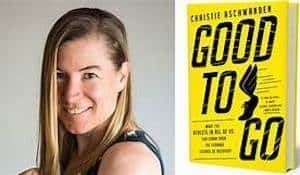
Her point is that the number of sets and reps are less important than certain fundamentals, such as:
- Consistency — just put out a consistent effort and work to progressively get better/stronger.
- No equipment needed — strength training can be done at home with minimal or even zero equipment — A 2017 study found that pushups and bench press produced similar muscle and strength gains when done at a similar load, which is true, I assert, with most body weight exercises. Such exercises can certainly be made more difficult as you progress (one-leg squat, one-arm push up, etc.).
- Choose compound muscle groups — Exercises that target the major muscle groups (such as push-ups for chest, front delts (shoulder) and triceps, squats for thighs and glutes, and chin-ups for lats and biceps) use your time more efficiently and provide more bang for the buck in terms of strength, muscle development and metabolic conditioning.
- Intensity matters — In order to get stronger, you need to exercise with enough intensity that your muscles get fatigued, which can happen with a few reps and sets or more of both depending on the load (how much you’re lifting.).
- One set is enough — If your objective is just to be fit enough for healthy aging and to look good, one strenuous set of each exercise done two to three times per week is sufficient. (There is data that indicates once per week is helpful, but, really — you can do better than that!)
- Focus on progression — If you don’t improve the number of reps, sets or load, you’re not exercising with enough intensity. That said, at some point (say 80 years of age), just maintaining what you have will be a win.
If you’re not convinced that regular exercise is, along with diet, the best thing you can do for healthy aging, read my post, 7 Life-saving Reasons Exercise Is The Ultimate Anti-aging Pill. It begins like this:
Everyone wants an anti-aging pill. What most don’t know is that they already have one. Exercise is the ultimate anti-aging pill, verified by science, as you’ll soon see. Thing is, you need both resistance training (weight lifting/calisthenics) and cardiovascular conditioning.
How about some guidance to get your started?
Here’s Arnold (73 and going strong):
View this post on Instagram
Old, but not obsolete. T-bar rows are one of my favorite exercises. Here’s some Monday motivation!
I just had to sneak that in there. Arnold and his lot were my inspiration when I first got into resistance training as a 15-year old. The pulling movement he’s doing exercises the lats, lower back, biceps and forearms.
There are many other examples of various exercises in the links below.
Mobility training:
Functional Fitness:
And now we turn to diet.
Increase Healthspan With Diet
The best way I have to introduce you to the value of nutrition on your healthspan is by my review of Dr. Michael Greger’s best-selling book, How Not To Die.
Here’s how it begins:
You’ve heard it before. Perhaps from Grandma. But it bears hearing again: “Food is medicine”. How Not To Die is Dr. Michael Greger’s forthcoming book which reveals specific foods that can prevent and heal chronic diseases, and thus expand our healthspan.
I’ll get right to the bottom line: 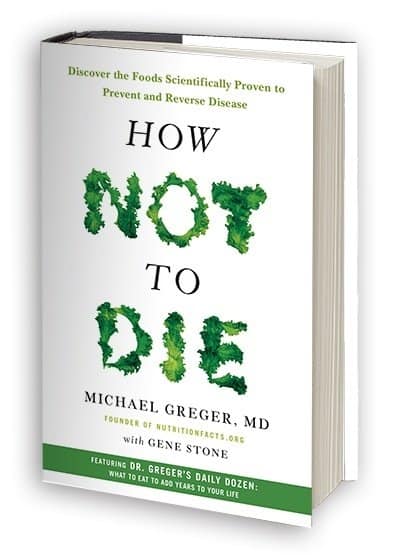
Eat more plants!
Plants have phytonutrients, and these natural chemicals provide the nutrients you need to get leaner and live longer, stronger.
They can be vegetables, greens, lentils, beans — and the more colorful the better.
The longest lived people in the world (the so-called “Blue Zones”) have one big thing in common — the food they eat; namely:
- Vegetables — A great source of fiber with different vitamins and minerals, consuming more than five servings of fruits and vegetables a day can significantly cut your risk of heart disease, cancer and death. (1)
- Legumes — Beans, peas, lentils and chickpeas are all rich in fiber and protein. A number of studies have shown that eating legumes correlates with lower mortality. (2,3,4)
- Whole grains — Rich in fiber, a high intake of whole grains can reduce blood pressure and is associated with reduced colorectal cancer and death from heart disease. (5,6,7)
- Nuts — Another great sources of fiber, nuts contain protein and polyunsaturated and monounsaturated fats, which combined with a healthy diet, are associated with reduced mortality, and may help reverse metabolic syndrome. (8,9)
The diets of people who live in the Blue Zones are typically 95% plant-based, eating meat only about five times per month. (10,11)
You want to improve your healthspan, possibly your lifespan? Eat like a Blue Zoner!
Your Takeaway
Remember these six things:
- Walking is good exercise, but you need to pick up the pace, or walk hills to increase healthspan.
- You’ll get more fit and age healthier if you add other exercises that benefit cardiovascular health, such as bicycling and swimming.
- Muscle loss is inevitable as you age, unless you fight back with muscle-building exercises.
- Exercise can regenerate stem cells to some degree. No pill can do that yet.
- Eat more plants, less processed meats.
- Some nutraceuticals have been studied that might increase healthspan, even lifespan. They include Senolytics, NAD+ precursors and upregulators of Autophagy.
Last Updated on February 7, 2024 by Joe Garma

